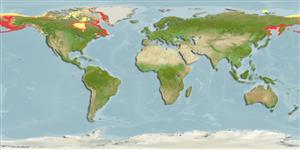Teleostei (teleosts) >
Perciformes/Zoarcoidei (Eelpouts and pricklebacks) >
Stichaeidae (Pricklebacks) > Stichaeinae
Etymology: Eumesogrammus: Greek, eu = good + Greek, mesos = half + Greek, gramma = signal, mark (Ref. 45335).
Environment: milieu / climate zone / depth range / distribution range
Ecology
Marine; benthopelagic; depth range 5 - 400 m (Ref. 58426). Polar; 82°N - 48°N, 135°E - 43°W
Western Atlantic: Hudson Bay and Ungava to Labrador in Canada and western Greenland. North Pacific: Sea of Okhotsk, Bering Sea and Arctic Alaska (Ref. 6876).
Size / Weight / Age
Maturity: Lm ? range ? - ? cm
Max length : 22.0 cm TL male/unsexed; (Ref. 7251)
Occurs over sand to gravel-and-stone bottoms at depths of 16-400 meters, typically shallower than 70 meters (Ref. 51666). Benthic; feeds on crustaceans (Ref. 58426).
Life cycle and mating behavior
Maturities | Reproduction | Spawnings | Egg(s) | Fecundities | Larvae
Robins, C.R. and G.C. Ray, 1986. A field guide to Atlantic coast fishes of North America. Houghton Mifflin Company, Boston, U.S.A. 354 p. (Ref. 7251)
IUCN Red List Status (Ref. 130435)
Threat to humans
Harmless
Human uses
Tools
Special reports
Download XML
Internet sources
Estimates based on models
Preferred temperature (Ref.
123201): -1.6 - 2.1, mean -0.6 °C (based on 1228 cells).
Phylogenetic diversity index (Ref.
82804): PD
50 = 1.0000 [Uniqueness, from 0.5 = low to 2.0 = high].
Bayesian length-weight: a=0.00417 (0.00203 - 0.00854), b=3.23 (3.05 - 3.41), in cm total length, based on LWR estimates for this species & (Sub)family-body (Ref.
93245).
Trophic level (Ref.
69278): 3.5 ±0.50 se; based on food items.
Resilience (Ref.
120179): Medium, minimum population doubling time 1.4 - 4.4 years (Preliminary K or Fecundity.).
Fishing Vulnerability (Ref.
59153): Low vulnerability (12 of 100).
